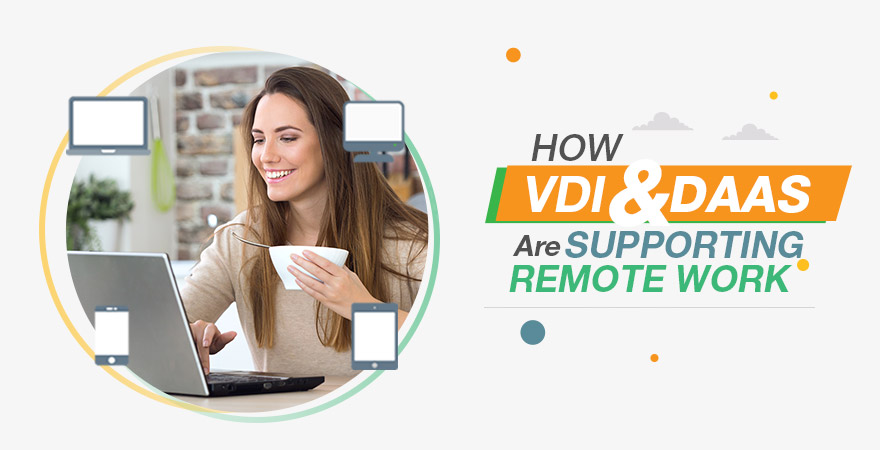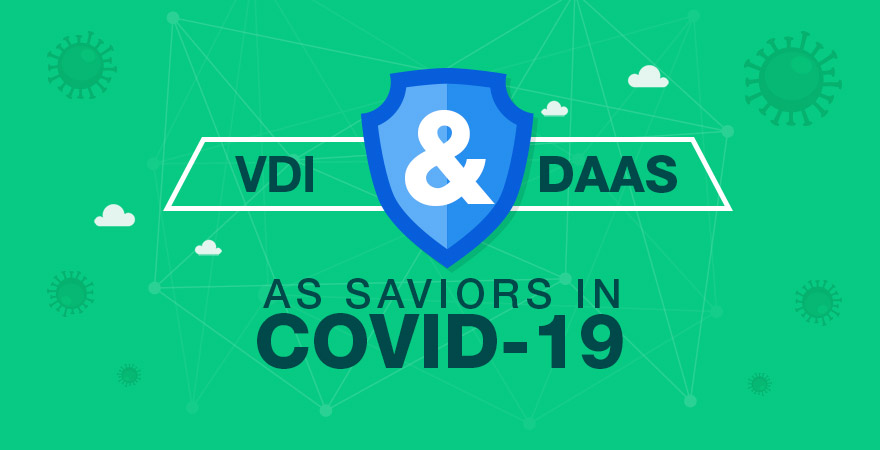The ensuing Covid-19 pandemic has transformed the way millions of people are executing their day to day workloads. Amidst this global pandemic, the only viable option for organizations across the globe has been remote work.

Now, to make your workforce ready for remote work, especially in these circumstances is a daunting challenge in itself. This crisis has engulfed the whole world so fast that most organizations found themselves ill equipped to deal with the situation.
Also Read:
- Covid-19: A Catalyst for Desktop as a Service (DaaS) Demand
- List of 7 Best Desktop as a Service DaaS Providers 2020
- How Desktop as a Service Works?
How to make Remote Work Possible?
When you talk of making a sizable workforce remote ready, there are a number of challenges you will have to contend with. The first question to ask is which remote work infrastructure will you rely upon to accomplish this goal.

The two most obvious alternatives in this regard are Virtual Desktop Infrastructure (VDI) and Desktop as a Service (DaaS). Both architectures are designed to deliver Virtual Desktops (VD) to end users, albeit in different ways.
Now, the type of deployment model will depend on the unique remote work needs of each organization. In this post, we will compare and contrast both these remote work platforms so that you are in a much better position to decide which works best for you.
Virtual Desktop Infrastructure – VDI
VDI relies on delivery of Virtual Desktops through the on premise data center of the deploying entity. This deployment model gives the organization absolute control over its data and productivity applications.
The downside to VDI is that you need to procure and maintain costly IT hardware to setup a fully functional data center on premise. Then, if you want to extend the scope of these VDs beyond the office workspace, you need to add an additional layer of security via VPN.
A VPN or Virtual Private Network provides employees a secure gateway to access the data center of their organization and perform work over their Virtual Desktops. The internet acts as a bridge between the data center and end user.
The VDI model generally suits organizations that need to support a very large number of remote employees. Another compelling factor to go for VDI is that the organization handles data that is of a sensitive or highly regulated nature.
Also Read:
- 17 Benefits of dinCloud’s Desktop as a Service (DaaS)
- Future Report on Desktop as a Service (DaaS) Infrastructure
- dinCloud’s Desktop as a Service Solution DaaS “How It Works”?
Desktop as a Service – DaaS
The DaaS model of delivering Virtual Desktops to end users works in a different manner. In case of DaaS, VDs are served from the data centers of a third party Cloud Service Provider (CSP), which charges a usage fee for utilizing its infrastructure.
A good thing about the DaaS model is that the deploying entity does not need to worry about the capital expenses required to setup a data center in house. Secondly, your IT related operating expenses are also curtailed as hardware is minimal in this model.
The downside to a DaaS model is that you have to entrust your data, either wholly or partially to a third party, which is your cloud provider. However, CSPs employ a multi faceted approach to cyber security that is comprised of multiple layers.
Capability of VDI and DaaS
Although the capability of either VDI or DaaS will depend on the underlying hardware, both are many times more capable than even the most high end individual desktop or laptop computers. You can easily execute processing intensive workloads over both.
Take the example of architectural software or 3D modelling applications that require immense processing muscle. Even the most capable individual PCs will struggle, if not fail to execute such intense workloads in the least amount of time.
Scalability
The other great benefit is nearly instant scalability in case of both VDI and DaaS. As the underlying infrastructure is already deployed, you can instantly increase or decrease the number of Virtual Machines (VM) that you have deployed.
In contrast, if you decide to scale up in a conventional environment, you will first need to procure physical PCs as per your need, configure each machine individually and the same process would go on and on when applying updates or patches.
Ease of Access
Both VDI and DaaS offer a lot of ease in terms of accessibility options. All you need to access a Virtual Desktop over DaaS or VDI is an internet connection, a web browser and a very basic, low spec input device which can even be your smartphone or tablet.
VDI and DaaS as Saviors in Covid-19
The Covid-19 pandemic has warranted a Work from Home (WFH) exercise of epic proportions. However, only those organizations have shined amidst this chaos who already had a VDI or DaaS arrangement in place.

For them, it was just a matter of turning on the remote work switch and in a matter of hours or few days at the most, their entire workforce was remote ready. The same cannot be said about entities that had to scramble for such an arrangement in chaos.
Also Read:
- How to Make the Most of Virtual Meetings amidst Covid-19?
- Leveraging the Cloud to Cope With the Effects of Covid-19
- The Challenges of VDI in Post Covid-19 Scenario
DaaS – A Quick Remote Work Solution
This is where DaaS truly shines as opposed to VDI, which needs setting up an elaborate IT infrastructure in house. A quality DaaS provider like dinCloud has the capability to deploy Virtual Desktops for you in a matter of hours or days at the most.
That’s not all, dinCloud provides fully virtualized productivity applications that seamlessly integrate with your Virtual Desktops (dinHVD). We offer fully licensed and patched apps with our cloud services to deliver a secure and seamless end user experience.
dinCloud – Your Go To DaaS Provider
For your remote work needs specific to the Covid-19 crisis and beyond, dinCloud is the go to Cloud Service Provider (CSP) for all your remote work needs. Contact Us to discuss your remote work needs so that we can craft the optimal remote work solution for you.


